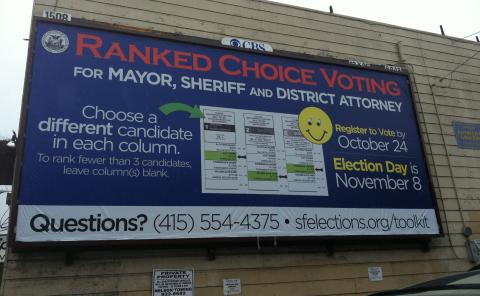Photo Credit: Steve Rhodes / Flickr
A new report by FairVote sheds light on the positive impacts of ranked choice voting (RCV) on candidates and voters of color. The comprehensive study analyzed 448 RCV elections over two decades, revealing key findings that highlight the benefits of this voting system.
From increased support for candidates of color to the avoidance of vote-splitting, the report breaks down RCV's use as a powerful tool for improving representation across the board in elections.
FairVote is a long-time advocate of RCV -- particularly, the proportional form of the alternative voting method. Its report underscores how historically marginalized and underrepresented communities experience notable success in RCV elections.
For example, the report spotlights the New York City, Salt Lake City, Minneapolis, and St. Paul city councils. Under RCV, the majority of the seats in these councils are now filled by people of color.
The first Alaska Native elected to Congress was also elected in an RCV election.
"As ranked choice voting grows across the country, it is delivering on its promises of representation,” said Deb Otis, FairVote’s Director of Research and Policy and co-author of the report.
“Candidates of color are running and winning in RCV elections. Candidates are building majority coalitions through positive campaigning and consolidating – rather than splitting – the power of their community. Voters of color are taking advantage of the opportunity to rank, and don’t feel forced to vote for the ‘lesser of two evils.’"
There are four key takeaways from FairVote's report.
Candidates of Color Benefit from the Counting Process
The counting process under RCV allows candidates of color to gain more support as lower-performing contenders are eliminated. In single-winner RCV races, these candidates significantly increase their vote share between the first and final round of tabulation at a much higher rate across the board.
No Penalties for Running Against Other Candidates of Color
RCV enables several candidates of color to run in the same race without the fear of "splitting the vote." When a candidate of color is eliminated, the study reveals that ballots are more likely to transfer to other candidates of the same ethnicity. This consolidation, rather than splitting, enhances the collective power of the community.
The report notes that the median Black candidate earned 6% more votes than expected when other Black candidates were eliminated, emphasizing the effectiveness of this system in ensuring fair representation.
Voters of Color Are More Likely to Rank the Candidates
Research indicates that voters of color tend to engage more actively in the electoral process when RCV is implemented. Case studies, such as the 2022 Oakland mayoral race, demonstrate that Black and Hispanic or Latino voters rank more candidates on average than white voters. RCV provides voters of color with the opportunity to express their preferences without feeling forced to choose the "lesser of two evils."
Across the Board Support for RCV
FairVote highlights broad support for RCV among naturalized citizens and permanent residents. A digital survey conducted in May 2023 revealed that an overwhelming 81% of these population groups support ranked choice voting. Black and Hispanic or Latino respondents expressed the highest levels of support, emphasizing the broad appeal of RCV across diverse communities.
New York City Council Member Amanda Farias says she is proud to be a part of a majority-people of color city council and the first-ever New York City Council that has a female majority. She believes it is no surprise that it happened in RCV elections.
“This report confirms what those of us who've run in ranked choice contests have already experienced: Voters and candidates of color win with RCV," she said.
"For candidates, ranked choice voting is an opportunity to be more collaborative and get your message out in a positive way. For voters, it's an opportunity to participate more actively in the process and get real representation."
RCV is the fastest growing voting reform in the country. FairVote reports that as of November 2023, the voting method spans 50 jurisdictions across the nation, including 2 states (Alaska and Maine). Combined, these areas are home to over 13 million people.
More states, counties, and cities will take up RCV's use in 2024, including Nevada -- which could become the third state to use RCV for statewide elections if voters approve the Final Five Voting measure that combines its use in general elections with nonpartisan primaries in November.
